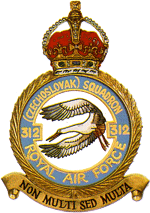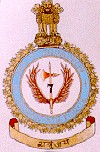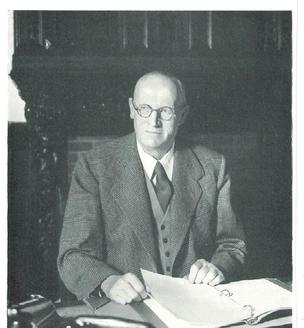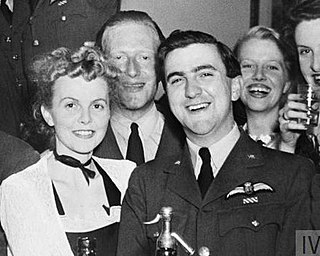Related Research Articles

The Gloster Meteor was the first British jet fighter and the Allies' only jet aircraft to engage in combat operations during the Second World War. The Meteor's development was heavily reliant on its ground-breaking turbojet engines, pioneered by Frank Whittle and his company, Power Jets Ltd. Development of the aircraft began in 1940, although work on the engines had been under way since 1936.

The Red Arrows, officially known as the Royal Air Force Aerobatic Team, is the aerobatics display team of the Royal Air Force (RAF) based at RAF Waddington. The team was formed in late 1964 as an all-Royal Air Force team, replacing a number of unofficial teams that had been sponsored by RAF commands.

In aircraft, an ejection seat or ejector seat is a system designed to rescue the pilot or other crew of an aircraft in an emergency. In most designs, the seat is propelled out of the aircraft by an explosive charge or rocket motor, carrying the pilot with it. The concept of an ejectable escape crew capsule has also been tried. Once clear of the aircraft, the ejection seat deploys a parachute. Ejection seats are common on certain types of military aircraft.
Martin-Baker Aircraft Company Limited is a British manufacturer of ejection seats and safety-related equipment for aviation. The company was originally an aircraft manufacturer before becoming a pioneer in the field of ejection seats. The company's headquarters are in Higher Denham, Buckinghamshire, England, with other sites in France, Italy and the United States.

The Folland Gnat is a British compact swept-wing subsonic fighter aircraft that was developed and produced by Folland Aircraft. Envisioned as an affordable light fighter in contrast to the rising cost and size of typical combat aircraft, it was procured as a trainer aircraft for the Royal Air Force (RAF) as well as by export customers, who used the Gnat in both combat and training capacities.

The Gloster Javelin is a twin-engined all-weather interceptor aircraft that served with Britain's Royal Air Force from the mid-1950s until the late 1960s. It was a T-tailed delta-wing aircraft designed for night and all-weather operations and was the last aircraft design to bear the Gloster name. Introduced in 1956 after a lengthy development period, the aircraft received several upgrades during production to its engines, radar and weapons, including support for the De Havilland Firestreak air-to-air missile.

The Boulton Paul Defiant is a British interceptor aircraft that served with the Royal Air Force (RAF) during World War II. The Defiant was designed and built by Boulton Paul Aircraft as a "turret fighter" to meet the RAF requirement for day and night fighters that could concentrate their firepower on enemy bombers which were not expected to have fighter escorts due to the distance from Germany to the United Kingdom. The Defiant had all its armament in a dorsal turret offering the ability to fire in most directions. The same principle was used in the Royal Navy's Blackburn Roc which was also built by Boulton Paul.

JSC Research & Development Production Enterprise Zvezda, or R&D PE Zvezda, is a Russian manufacturer of life-support systems for high-altitude flight and human spaceflight. Its products include space suits, ejector seats, aircraft escape slides, lifejackets and fire extinguishers. It is based in Tomilino, near Moscow.

The Westland Wyvern is a British single-seat carrier-based multi-role strike aircraft built by Westland Aircraft that served in the 1950s, seeing service in the 1956 Suez Crisis. Production Wyverns were powered by a turboprop engine driving large and distinctive contra-rotating propellers, and could carry aerial torpedoes.

Number 31 Squadron, known as the Goldstars, is a squadron of the Royal Air Force. The Squadron lays claim to being the first military unit to fly in India, where it was based from 1915 to 1947. Throughout the Cold War, No. 31 Squadron was based in West Germany, flying from RAF Laarbruch and RAF Brüggen. Between September 1984 and March 2019, the Goldstars operated the Panavia Tornado GR1/4, initially from RAF Brüggen and after August 2001 from RAF Marham, Norfolk. No. 31 Squadron was disbanded on 14 March 2019 at RAF Marham and reformed on 11 October 2023 at RAF Waddington, Lincolnshire, equipped with the General Atomics Protector RG1.

An aircraft canopy is the transparent enclosure over the cockpit of some types of aircraft. An aircraft canopy provides a controlled and sometimes pressurized environment for the aircraft's occupants, and allows for a greater field of view over a traditional flight deck. A canopy's shape is a compromise designed to minimize aerodynamic drag, while maximizing visibility for pilots and other crewmembers.

No. 312 Squadron RAF was a Czechoslovak-manned fighter squadron of the Royal Air Force in the Second World War.

No. 7 Squadron IAF operates as a Special Munitions Delivery and air superiority unit. Based at Gwalior AFB, No. 7 Squadron forms a part of 40 Wing AF, Central Air Command.

The CAC Sabre, sometimes known as the Avon Sabre or CA-27, is an Australian variant of the North American Aviation F-86F Sabre fighter aircraft. The F-86F was redesigned and built by the Commonwealth Aircraft Corporation (CAC). Equipping five Royal Australian Air Force (RAAF) squadrons, the type saw action in the Malayan Emergency in the late 1950s and was employed for air defence in Malaysia and Thailand in the 1960s. Ex-RAAF models also saw service with the Royal Malaysian Air Force and the Indonesian Air Force.

The Hafner Rotabuggy was a British experimental aircraft that was essentially a Willys MB combined with a rotor kite, developed with the intention of producing a way of air-dropping off-road vehicles.
Marcel Lobelle was a Belgian aeronautical engineer who spent his professional career working in Britain.

Sir Arthur Noel Mobbs (1878–1959) was the founder of Slough Estates, one of the United Kingdom's largest property businesses.

Sqn Ldr Trevor Sidney "Wimpy" Wade, was a Royal Air Force (RAF) fighter ace, one of The Few and later a test pilot. He was killed test flying the Hawker P.1081 prototype fighter.

The Martin-Baker Mk.1 is a British ejection seat designed and built by Martin-Baker. Developed in the late 1940s it was the first in the line of production Martin-Baker seats for military aircraft. Ground and air testing of earlier designs resulted in the first successful test ejection of a company employee in July 1946. A seat type designed for the Saunders-Roe company was known as the Pre-Mk.1.
Duncan Menzies Soutar Simpson was a Scottish test pilot who played a key role in the development of the Hunter aircraft, the Harrier, and the Hawk advanced trainer flown by the RAF’s Red Arrows. He was the former chief test pilot of Hawker Siddeley in the 1970s. He flew the first production Harrier aircraft in December 1967, and the first two-seat Harrier in April 1969.
References
Notes
- ↑ Mobbs, together with Percival Parry had formed Slough Estates in 1920, Slough Estates was the owner of Slough Trading Estate where R. Malcom operated.